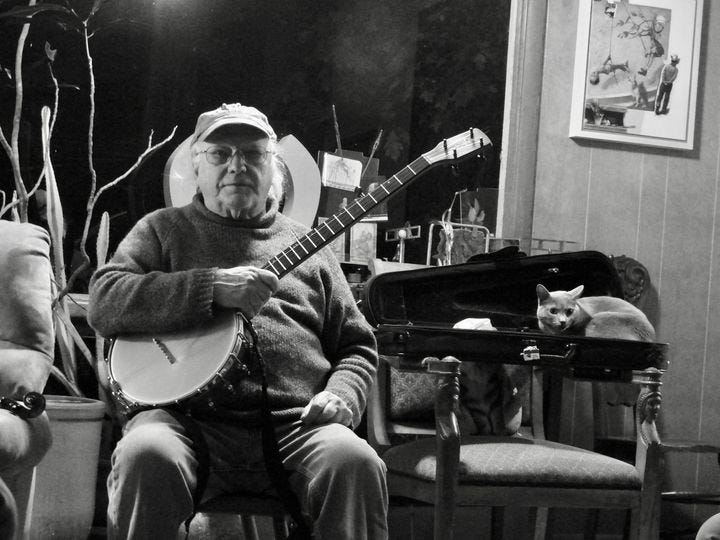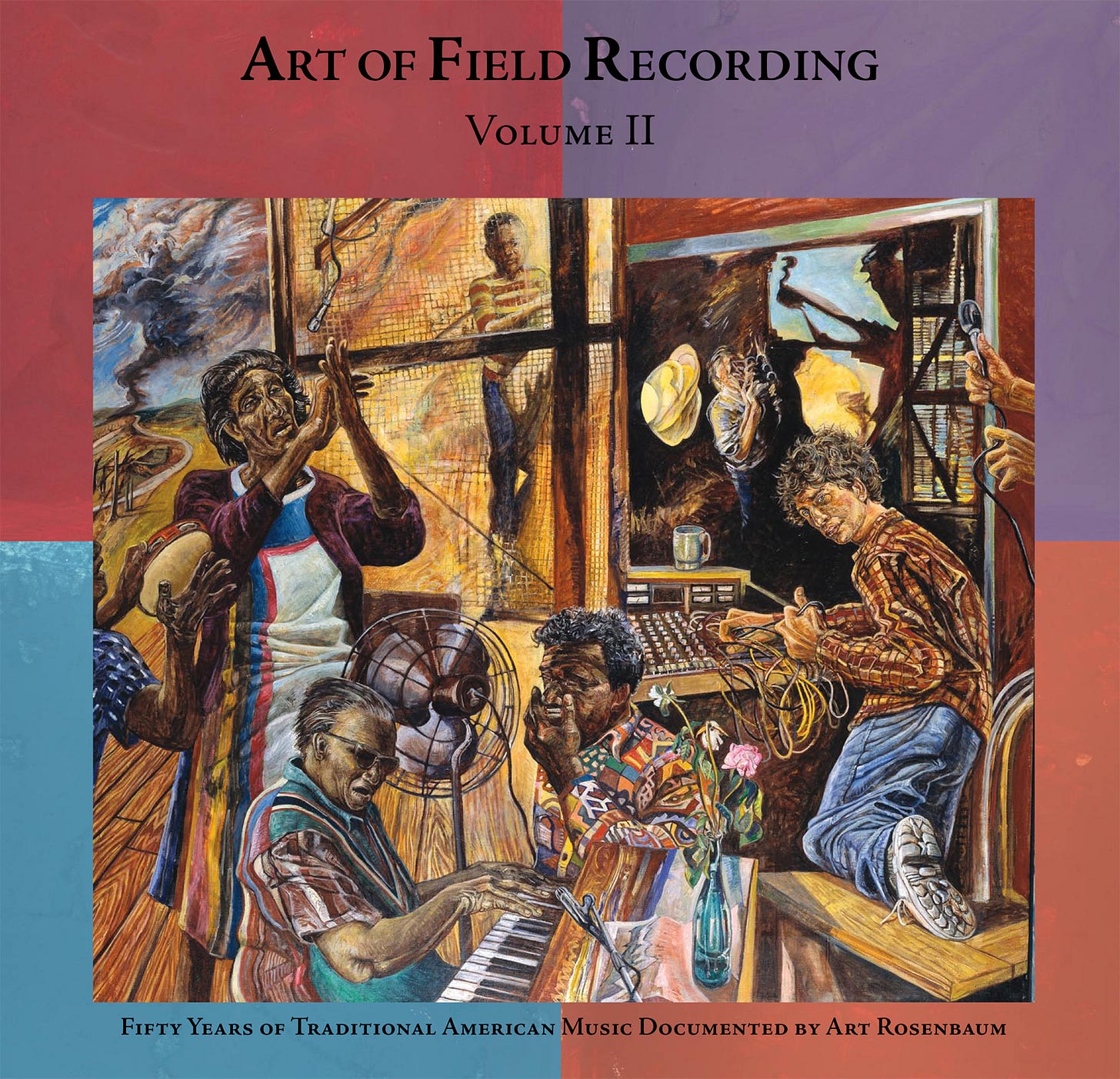Remembering Art Rosenbaum, December 6, 1938 — September 4, 2022
The passing of a colleague, friend, and mentor.
I met Art Rosenbaum on October 7, 2004. It was almost a year to the day after the release of Dust-to-Digital’s first production, the six-CD, 200-page-book, box set Goodbye, Babylon. Upon receiving encouragement from mine and Art’s mutual friend George Mitchell, I sent Art a letter which led to us coordinating a time to meet for lunch. At Art’s suggestion, we had fish and chips at The Globe in downtown Athens, and he explained to me that the large mural behind the bar was an artwork he had created on a trip to Cortona, Italy where he oversaw summer trips with art students attending the University of Georgia where Art taught painting and drawing.
After lunch, Art took me to the university library. We took the elevator down to the their archive where the entire collection of Art’s reel-to-reel tapes was kept in storage. He told me how some of his recordings had been used on albums for record labels like Folkways, Rounder, Fantasy, and Prestige Bluesville, but that there was still a wide range of recordings that he had made which had never been issued. We went back to Art’s house a few miles from downtown Athens and the university, and the two of us began discussing future plans to see if anything lined up for us to work together on a project.
That discussion evolved over email, and by 2005, Art was working with Ruta Abolins and her staff at the UGA Library to digitize the audio on the reels of tape that Art had made and deposited in their archive. He and I would spend the next year and a half listening to the recordings and making notes for what should be included on the upcoming Dust-to-Digital release. The two-CD set we had originally envisioned expanded to two four-disc box sets, which would later be recognized by the Recording Academy as the Best Historical Album in 2009, something we could have never foreseen.
Art was a very special person with a wide variety of interests and passions. His mind contained a database of vernacular music. But unlike AI or any algorithm, when Art recalled a particular song or tune from the thousands that he knew, he did so with warmth and tenderness because he was drawing from the memories he had with the people who taught him their music.
In the years we spent working together, listening to the music he recorded, discussing the artists that he had encountered, I learned so much. Together, he and I compiled what we believed to be an essential piece of the panoramic puzzle of traditional music made in America.
Art Rosenbaum on his approach for the liner notes for the Art of Field Recording box sets: “This project is mainly an aural presentation and compilation of American traditional music, recorded in the field. It is not a scholarly work and does not propose any major theories or definitive notions on the genres or individual selections included… In listening to these recordings, the setting and human encounter of each session has re-emerged in my consciousness; and I hope to evoke these in a way that transcends the anecdotal, though my relationship with this form of expressive art, especially the performances here, must be to a degree personal and subjective. I can’t help but be engaged, but I also will try to step back and let the voices and instruments speak for themselves. Most of the performers heard here are deceased—and these performances have become their legacy, for which we are indebted.”
Art Rosenbaum on his approach for creating artworks featuring musicians he recorded: “I have been making drawings and paintings relating to traditional music since my teens, certainly since I began recording and learning about the music first-hand. Images, themes, and oblique associations from the people and musical traditions I encountered have entered and informed my art in many ways: from fairly direct depictions of musicians to more personal allegorical paintings in which the music, the people, and the environment are part of a complex view of the human situation; to abstract works, at times triggered by a melody, a song, or a title of a fiddle tune. In Iowa, Margo became very involved in photography, and photographed many of the performers we recorded there. Since we moved to Georgia her photography has been a key element of our field work and has been part of two traveling exhibitions and two hard-cover books that we assembled from our work with Georgia traditional musicians and singers. And, since the crux of the Art of Field Recording is our personal intersection with the performers and their music, we have chosen to use only the photographs, drawings, and paintings, that we made and which came out of that person-to-person connection; rather than to draw on older historical or family photographs and images. Finally, it is “the singer not the song” that is represented in the visuals; we depict the performers and their environments as we saw and interpreted them, leaving it to the listener to create mental pictures of the stories told or the emotions and associations generated by the music, as the performers would wish.”
Art Rosenbaum: “How do you make a blues number? What do you think about or study? How does it come to you?”
Cecil Barfield: “In mind... In heart and mind. What your heart do, your mind be right along with it. And what your mind be, you got to get your fingers with it to make the music. You got to get all that together. You got to get your song together. You got to get your music together. And when you get it all together you ain’t got nothing to do but to play it. And when you get to playing it, the more you play it, the more it comes to you.” — Cecil Barfield describing his creative process to Art Rosenbaum in 1989.
Mabel Cawthorn: “I got pretty good at taking two little empty snuff boxes.”
Art Rosenbaum: “Really?”
Mabel Cawthorn: “I beat them two snuff boxes together.”
Art Rosenbaum: “You can make music out of anything.”
Mabel Cawthorn: “I can. If there’s any music in it, I’ll get it out of it.”
— Mabel Cawthorn talking to Art Rosenbaum at her home in Carnesville, Georgia in 1989.
















Clearly a great person. The self portraits on the covers are wonderful. Sorry I never met him.
Thank you for your lovely remembrance of such a wonderful and compassionate soul. What an amazing opportunity to share Arts gifts with the world. We are never sure where grace finds us in the end, but I know there will be music. Sending love and comfort for his loss.